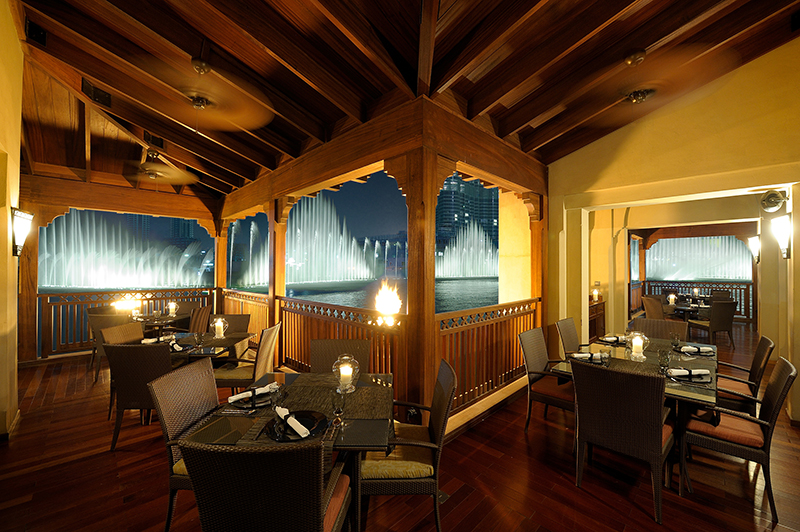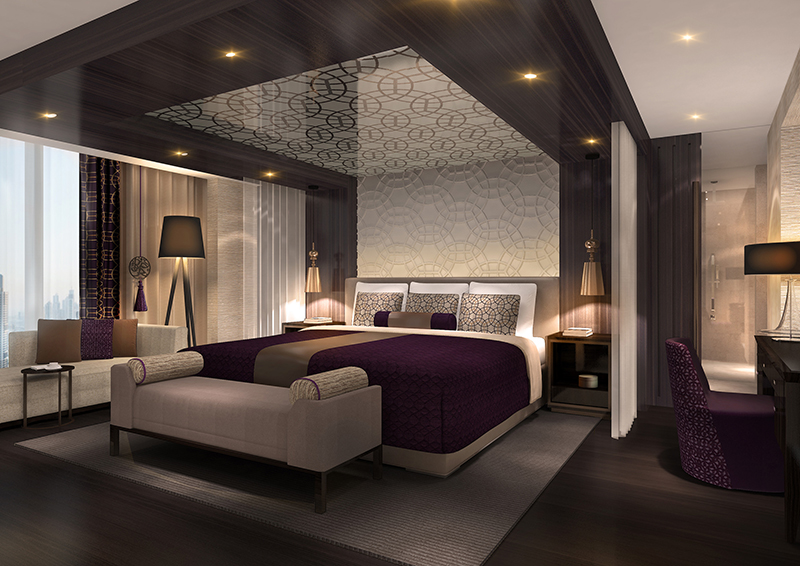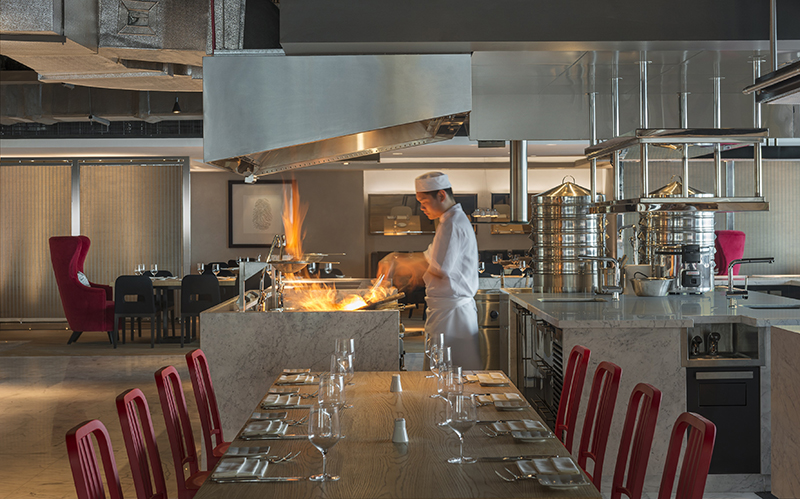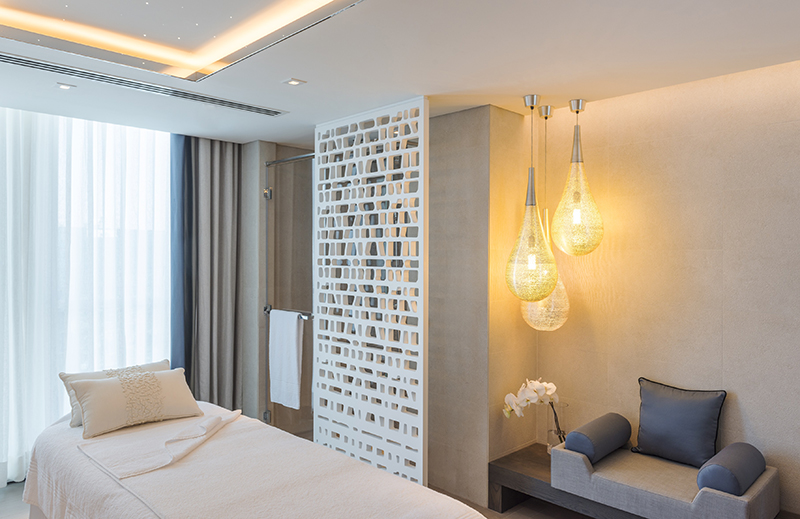

Thiptara Terrace, Photo Credit: The Address Hotel and Resort
Dubai’s rise from a modest fishing and pearl-diving center to the Middle East’s most cosmopolitan city, a hub of both commerce and culture, is rightly intriguing to many curious visitors.
While the dynamic cityscape of skyscrapers, massive shopping malls, luxury hotels, plush waterfront communities and a surprisingly multicultural vibe are all reasons enough to travel here, you might want to venture off the beaten path to delve into the heritage of the city.
With this 48-hour itinerary, pepper your exploration of modern-day Dubai with a walk down memory lane that brings you face to face with the city’s history and traditions.

Sheraton Grand Hotel, Dubai, Photo Credit: Marriott International Inc.
Day One
Stay at Sheraton Grand Hotel, Dubai, a stylish contemporary hotel, conveniently located on Sheikh Zayed Road that offers easy access to the metro, the city’s best restaurants and bars, and other areas of interest. And it doesn’t hurt that the property itself captivates with well-appointed rooms, a well-regarded spa and a rooftop poolside bar that goes well beyond what you’d expect.
To get a sense of Dubai’s deeply ingrained love for business, head to the city’s oldest markets in Deira, a short abra (traditional wooden boat) ride from the creek in Bur Dubai. Among the last few remaining souks (traditional markets) in Dubai, your visit to the Spice Souk mid-morning is perfectly timed for when shopkeepers have just set up storefront displays — sacks of red chilies, saffron, cardamom, rose petals, turmeric and other spices from Iran, Yemen, India and parts of Africa. You’re welcome to sample local date varieties, dry fruits and nuts before you buy.
It’s a short walk next door to the Gold Souk, where windows are dressed with gold, silver and diamond jewelry; regal necklaces, chunky bangles and beautiful earrings studded with precious stones. Locals and visitors from around the Middle East and South Asia are the biggest buyers here.
If like many others, you’ve wondered about the role of women in Emirati society, the Women’s Museum, founded by academic Rafia Ghubash, is a good place to get some perspective. Exhibits feature the work of female artists and poet Ousha Bint Khalifa.
https://www.instagram.com/p/BO60KbID18q/?taken-by=alfanarrestaurant
For an introduction to Emirati cuisine, make the trip to Al Fanar Restaurant and Café. The interior transports you to 1960s Dubai, of wind towers, rustic courtyards, barasti huts and old Land Rovers. The food is authentic Emirati, a rarity in a city where foreign cuisines constantly compete for your attention.
Tuck into hot samboosa (meat pastry) and hobool (deep-fried fish roe). For mains, try the aromatic machboos deyay (chicken cooked with spicy rice). The dessert of leqaimat (fried dough balls in date syrup) is decidedly sinful.
Post-lunch, there’s no place better (or bigger) than the Dubai Mall to burn off those calories and indulge in some retail therapy offered by the likes of Alexander McQueen, Elie Saab and Ralph Lauren.
An hour before sunset, head to At The Top to enjoy awe-inspiring views from the observation deck on the 124th floor of the Burj Khalifa, the world’s tallest skyscraper that defiantly reaches for the sky, much like the city’s ambition.
https://www.instagram.com/p/BTeWCTJD01S/?taken-by=zaroob
For a modern take on Levantine street food, join the locals and dine at Zaroob. The restaurant is always busy, but you realize that the wait is worth it once you’ve taken a bite of the crispy tahini-dunked falafels and the creamy hummus. Try the man’oushe (spicy meat, vegetables and sauces wrapped in soft flatbread) for a taste of even more epicurean ecstasy.
Return to the Sheraton Grand to enjoy signature cocktails and easy jazz at Moe’s on the 5th before you call it a night.

Feast, Photo Credit: Marriott International Inc.
Day 2
Start the day with a leisurely breakfast at Feast at Sheraton Grand Hotel, Dubai and gear up for another action-packed itinerary.
Your first stop is the Dubai Museum, housed in Al Fahidi Fort, the city’s oldest structure that was built in 1787. Interactive displays, photographs and exhibits give insight into the life of Bedouin tribes, fishermen and traders in the early days. You’ll time travel as you walk through a village and hear the clunking of a blacksmith’s tools, pass by a school where students listen to a teacher’s lessons, witness typical market scenes and enter a traditional home and date farm.
A few hundred feet away is the heritage district of Al Bastakiya, which dates from the late 19th century and once served as the home to wealthy merchants. A far cry from modern-day Dubai, these restored buildings were originally made of coral, limestone, mud and plaster, with wind towers and courtyards, all features that have been maintained to preserve the architectural style.
Wander around the maze-like alleys and enter the buildings to find teahouses, artist studios, galleries, boutiques and the one-of-a-kind XVA Art Hotel & Café, a heritage hotel with a café that’s popular with those seeking a quiet corner in the busy city.

Shine Spa, Photo Credit: Marriott International Inc.
Head to the Sheikh Mohammed Centre for Cultural Understanding in House 26 in time for a cultural lunch (1 p.m. Sunday through Thursday, reservations only) where you can feast on mouthwatering traditional dishes and engage a local host in discussions about Emirati culture, customs and society.
For a little rejuvenation, head back to the Sheraton Grand and get a Swedish massage at Shine Spa. Peruse the facilities before you step out for a special evening.
Dress to impress and head to Dubai Opera, the city’s newest and, perhaps, most impressive performing arts venue. The boat-shaped exterior of the building in downtown Dubai, designed by architect Janus Rostock, is a nod to the city’s roots as a trading port. The new landmark hosts internationally acclaimed performances and recently staged productions like Cats and Mary Poppins.
Celebrate your last night in Dubai with drinks and Thai seafood specialties at the elegant Thiptara by Burj Lake. The fantastic view of the dancing Dubai Fountain serves as a fitting goodbye to the city.
